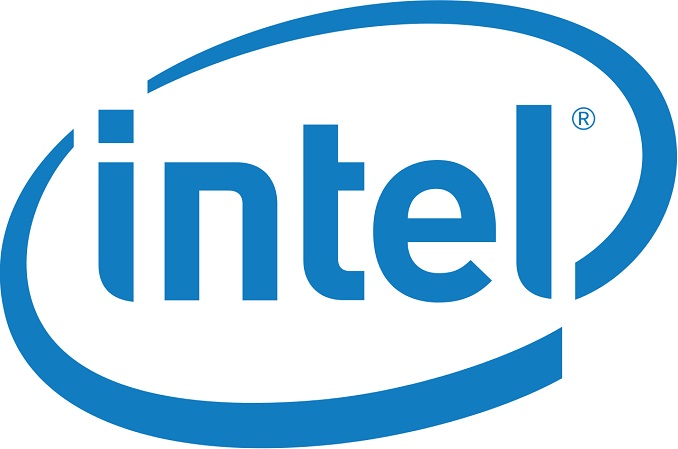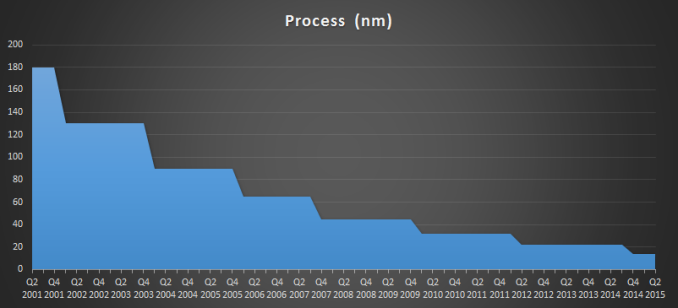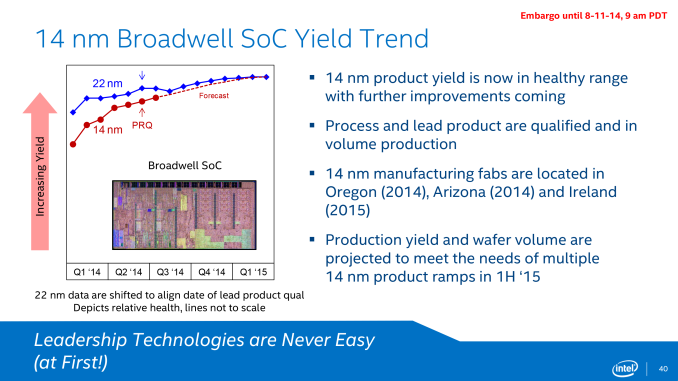Tick Tock On The Rocks: Intel Delays 10nm, Adds 3rd Gen 14nm Core Product "Kaby Lake"
by Brett Howse & Ryan Smith on July 16, 2015 10:15 AM EST
For almost as long as this website has been existence, there has been ample speculation and concern over the future of Moore’s Law. The observation, penned by Intel’s co-founded Gordon Moore, has to date correctly predicted the driving force behind the rapid growth of the electronics industry, with massive increases in transistor counts enabling faster and faster processors over the generations.
The heart of Moore’s Law, that transistor counts will continue to increase, is for the foreseeable future still alive and well, with plans for transistors reaching out to 7nm and beyond. However in the interim there is greater concern over whether the pace of Moore’s Law is sustainable and whether fabs can continue to develop smaller processes every two years as they have for so many years in the past.
The challenge facing semiconductor fabs is that the complexity of the task – consistently etching into silicon at smaller and smaller scales – increases with every new node, and trivial physics issues at larger nodes have become serious issues at smaller nodes. This in turn continues to drive up the costs of developing the next generation of semiconductor fabs, and even that is predicated on the physics issues being resolved in a timely manner. No other industry is tasked with breaking the laws of physics every two years, and over the years the semiconductor industry has been increasingly whittled down as firms have been pushed out by the technical and financial hurdles in keeping up with the traditional front-runners.
The biggest front runner in turn is of course Intel, who has for many years now been at the forefront of semiconductor development, and by-and-large the bellwether for the semiconductor fabrication industry as a whole. So when Intel speaks up on the challenges they face, others listen, and this was definitely the case for yesterday’s Intel earnings announcement.
As part of their call, Intel has announced that they have pushed back their schedule for the deployment of their 10nm process, and in turn it has affected their product development roadmap. Acknowledging that the traditional two year cadence has become (at best) a two and a half year cadence for Intel, the company’s 10nm process, originally scheduled to go into volume production in late 2016, is now scheduled to reach volume production in the second half of 2017, a delay of near a year. This delay means that Intel’s current 14nm node will in effect become a three year node for the company, with 10nm not entering volume production until almost three years after 14nm hit the same point in 2014.
Intel’s initial struggles with 14nm have been well publicized, with the company having launched their 14nm process later than they would have liked. With their 22nm process having launched in Q2 of 2012, 14nm didn’t reach the same point until Q4 of 2014, and by traditional desktop standards the delay has been even longer. Ultimately Intel was hoping that the delays they experienced with 14nm would be an aberration, but that has not been the case.
Intel’s latest delay ends up being part of a larger trend in semiconductor manufacturing, which has seen the most recent nodes stick around much longer than before. Intel’s leading node for desktop processors in particular has been 22nm for close to three years. Meanwhile competitors TSMC and Samsung have made much greater use of their 28nm nodes than expected, as their planar 20nm nodes have seen relatively little usage due to leakage, causing some customers to wait for their respective 16nm/14nm FinFET nodes, which offer better electrical characteristics at these small geometries than planar transistors. Observationally then there’s nothing new from Intel’s announcement that we haven’t already seen, but it confirms the expected and all too unfortunate news that even the industry’s current bellwether isn’t going to be able to keep up with a traditional two year cadence.

Intel Historical Development Cadence
Meanwhile the fact that 14nm is going to be around for another year at Intel presents its own challenges for Intel’s product groups as well as their fabrication groups, which brings us to the second part of Intel’s announcement. Intel’s traditional development model for processors over the last decade has been the company’s famous tick-tock model – releasing processors built on an existing architecture and a new manufacturing node (tick), and then following that up with a new architecture built on the then-mature manufacturing node (tock), and repeating the cycle all over again – which in turn is built on the two year development cadence. Intel wants to have new products every year, and alternating architectures and manufacturing nodes was the sanest, safest way to achieve that. However with the delay of 10nm, it means that Intel now has an additional year to fill in their product lineup, and that means tick-tock is on the rocks.
Previously rumored and now confirmed by Intel, the company will be developing a 3rd generation 14nm Core product, to fit in between the company’s forthcoming 14nm Skylake (2015) and 10nm Cannonlake (2017) processor families.
| Intel Core Family Roadmap | ||||
| Previous Roadmap | New Roadmap | |||
| 2014 | Broadwell | Broadwell | ||
| 2015 | Skylake | Skylake | ||
| 2016 | Cannonlake | Kaby Lake (New) | ||
| 2017 | (10nm New Architecture) | Cannonlake | ||
| 2018 | N/A | (10nm New Architecture) | ||
The new processor family is being dubbed Kaby Lake. It will be based on the preceding Skylake micro-architecture but with key performance enhancements to differentiate it from Skylake and to offer a further generation of performance improvements in light of the delay of Intel’s 10nm process. Intel hasn’t gone into detail at this time over just what those enhancements will be for Kaby Lake, though we are curious over just how far in advance Intel has been planning for the new family. Intel has several options here, including back-porting some of their planned Cannonlake enhancements, or looking at smaller-scale alternatives, depending on just how long Kaby Lake has been under development.
Kaby Lake in turn comes from Intel’s desire to have yearly product updates, but also to meet customer demands for predictable product updates. The PC industry as a whole is still strongly tethered to yearly hardware cycles, which puts OEMs in a tight spot if they don’t have anything new to sell. Intel has already partially gone down this route once with the Haswell Refresh processors for 2014, which served to cover the 14nm delay, and Kaby Lake in turn is a more thorough take on the process.
Finally, looking at a longer term perspective, while Intel won’t be able to maintain their two year development cadence for 10nm, the company hasn’t given up on it entirely. The company is still hoping for a two year cadence for the shift from 10nm to 7nm, which ideally would see 7nm hit volume production in 2019. Given the longer timeframes Intel has required for both 14nm and 10nm, a two year cadence for 7nm is definitely questionable at this time, though not impossible.
For the moment at least this means tick-tock isn’t quite dead at Intel – it’s merely on the rocks. What happens from here may more than anything else depend on the state of the long in development Extreme Ultra-Violet (EUV) technology, which Intel isn’t implementing for 10nm, but if it’s ready for 7nm would speed up the development process. Ultimately with any luck we should hear about the final fate of tick-tock as early as the end of 2016, when Intel has a better idea of when their 7nm process will be ready.
Source: Intel Earnings Call via Seeking Alpha (Transcript)











138 Comments
View All Comments
hakime - Thursday, July 16, 2015 - link
"The biggest front runner in turn is of course Intel, who has for many years now been at the forefront of semiconductor development, and by-and-large the bellwether for the semiconductor fabrication industry as a whole"This is so much bullshit and so much typical of the bias towards Intel that Anandtech has, basically since this site started. Intel has surely contributed a lot to the semiconductor development but calling it a bellwether in this industry is plain flat wrong.
Not trying to defend anyone here but IBM has had as much as a big contribution to the industry, I can name a few examples right away: copper interconnect, Silicon On Insulator, graphene chips, big contribution in the development of III-V semiconductors, the first carbon nanotube transistor and of course the recent announcement of their 7 nm chip.
So let's not say stupid things, thanks.
Kristian Vättö - Thursday, July 16, 2015 - link
While IBM has undoubtedly made big contributions, most items on your list are technologies that at least currently only exist in R&D labs. It's one thing to develop a new technology and perhaps show a prototype of it; making it viable for mass production is where the real complexity is. Frankly, Intel has been at the forefront of that for several years now, although it will be interesting to see if Samsung and IBM can catch up.krumme - Thursday, July 16, 2015 - link
"Rocks..."When the Anandtech boss participate in the writing for especially Intel or to a lesser degree NV there is always this spinning of the words, that at least for me leaves me with a feeling a little bit like a PR piece. Only Ryan and Anand can/could twist the words like that. Just a bit and very subtle. I am pretty sure that when you read it Kristian you know what i am talking about.
There is plenty good, valid reasons to slow down development. Why do we have to hear all this - in my ears - bs i dont understand. Why not explain why its slowing down and the reasons for it, technical and economic. Thats what i expect from AT. Not this.
Kristian Vättö - Thursday, July 16, 2015 - link
We have actually explained the slow down in lithography shrinks. Well, not directly under that title, but if you read the full article linked below you will understand why the developments are now taking longer. In short, to get down to 10nm economically, it's likely that a new lithography technology needs to be used, which is a huge step for the industry because AF laser has been used for well over a decade now. The issue is that there's no one technology that is truly ready to carry the sword yet.http://www.anandtech.com/show/8223/an-introduction...
krumme - Friday, July 17, 2015 - link
yeaa. This is a blast of an article i know that.Most of it is over my head, but i prefer it to this fairy tale picture of Moores law is still very much there - when it clearly isnt.
What is Intels interest in upholding that story actually? Why this hell bend protecting of this stupid irrelevant "law" or symbol? - Its not like their profit is dependant on it any more.
tarlinian - Thursday, July 16, 2015 - link
Exactly one of those has turned out to be practical: copper interconnect. If you ask anyone in the industry, Intel has led the way for the entire last decade while IBM led its happy followers down the dead end path of SOI and biaxially strained channels.dealcorn - Thursday, July 16, 2015 - link
Does Best Buy offer any product with Silicon On Insulator, graphene chips, or III-V semiconductors?Zizy - Thursday, July 16, 2015 - link
Possibly some old AMD gear with SOI. Unlikely to see IBM gear on sale there.3-5 is getting ready and you can find a chip here or there. Not at best buy of course.
Graphene is far far away, even photonics is closer, as is neural chips stuff. Heck, even quantum computing is closer than graphene.
MrSpadge - Thursday, July 16, 2015 - link
Of course: any system with an AMD CPU that's not an APU uses SOI. Didn't help them all that much, though.And III-V: almost all LEDs which are not OLEDs are using III-V semiconductors. Some are probably using II-VI, but research-wise that's all the same non-CMOS playing ground. They're also used in high-performance power electronics. Not sure in which Best Buy products they are, but chances aren't too bad.
And the Quantum Computer: first models are commercially available, just not at Best Buy and definitely not for everyone.
3DoubleD - Thursday, July 16, 2015 - link
Don't forget that almost all 3G and LTE radios have been III-V. Only very recently has Si CMOS been able to drive these radios. So lots of III-V products available at Best Buy.